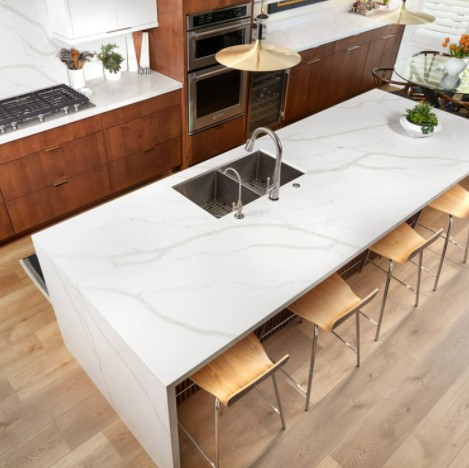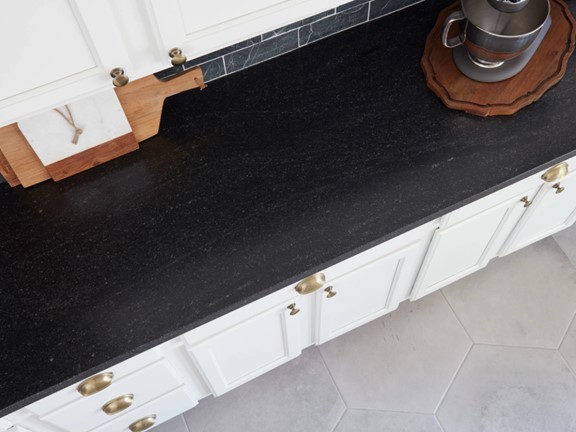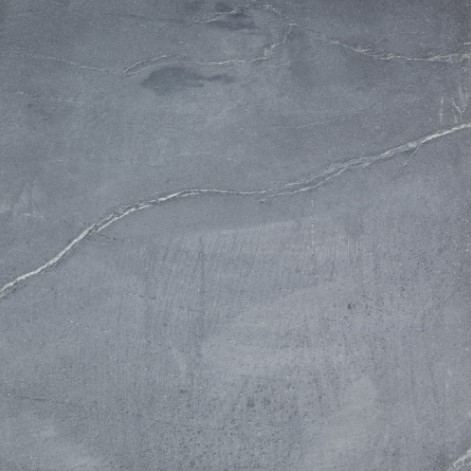
Featured Image: Bertoli Quartz Waterfall Kitchen Island Slabs from Arizona Tile
You can transform the look of a whole room by replacing the countertops with a gorgeous stone slab. Some stone slabs, like granite, quartz, quartzite, soapstone, and other luxurious stones, can also elevate your backsplash, shower walls, and more, for a complete design upgrade.
When it comes time to actually choose your stone slab, you may feel overwhelmed by decisions. You’ll have to choose the material, color, finish, application, and thickness. To help you make one of those decisions, let’s take a closer look at thickness. In this guide, you’ll learn if thin or thick stone countertops are best for your project.
What is the Standard Stone Countertop Thickness?
The standard stone countertop thickness is 2 or 3 cm. For example, the stunning Bertoli quartz slab comes in two thickness options: 2 cm and 3 cm. Durability, cost, location, appearance, and your fabricator’s recommendations are all important factors when deciding between these two thicknesses.
How to Choose Between Thick or Thin Stone Countertops
When determining if 2 or 3 cm thickness is right for you, there are several factors to consider:
Durability
One thing to consider is durability. Fortunately, once the slab is installed, their durability should be almost the same. Your fabricator will have to take many precautions, like careful handling or installing extra support, but once it is installed, both 2 cm and 3 cm countertops are durable and great choices. Your fabricator might have durability considerations, so always talk to them before making a decision.
Cost
There are many factors at play for total cost. When your fabricator first buys a slab, the initial cost is higher for the 3 cm thickness because they are buying 1/3 more stone with the thicker option. It also costs more to ship the heavier, thicker stone. Initially, this makes it seem like the thicker option is more expensive, but this has not yet factored in the installation costs.
If you choose a thinner countertop, your fabricator will cut and laminate an extra piece of stone around the edge of the countertop to make it look thicker. Typically, fabricators don’t take this extra step with 3 cm countertops. Since the thinner 2 cm countertop is more fragile, it’s also more difficult and therefore more expensive to handle due to risk of damage. Fabricators also have to install an extra wood layer first when installing a 2 cm countertop to add extra support and increase its durability.
Ultimately, 2 cm and 3 cm countertops usually end up costing almost the same amount. Either way, you are looking at very similar costs. Your fabricator will be able to give more specific numbers.
Appearance of Edges
Fabricators add and laminate a separate piece of stone to the edge of the 2 cm countertop to make it look thicker. Sometimes, people don’t like the way this can look if the contrast between the two pieces is noticeable. If that’s the case, you may want to go with the 3 cm countertop instead. On the other hand, if this stone slab is for vertical use, like a backsplash, this factor would no longer be an issue.
Location
Although the durability should be about the same if the slab is installed properly, your desired location for the slab is still worth considering. For example, if you have your heart set on a large countertop overhang, your fabricator may recommend the thicker option. For vertical application, like for a fireplace or wall, the lighter 2 cm option may be better. You may even use both thicknesses in your project, like with one as the backsplash and the other as the countertop.
 Image: Black Mist Honed Granite Countertop for Interior and Exterior Use from Arizona Tile
Image: Black Mist Honed Granite Countertop for Interior and Exterior Use from Arizona Tile
Interior vs. Exterior Application
In most cases, fabricators and tile professionals see minimal to no difference between the two thicknesses. One exception is for exterior use. If you are planning to have your countertop installed outside, like for an outdoor kitchen or BBQ top, a 3 cm thick countertop is recommended. Due to temperature changes and weather, your countertop may expand and contract over time. With a thicker countertop material, like our Black Mist Honed granite, this risk is greatly reduced, and your exterior countertop will hold up better in the long run.
 Image: 3cm Thick Churchill Soapstone Slab from Arizona Tile
Image: 3cm Thick Churchill Soapstone Slab from Arizona Tile
Trends and Personal Preferences
Even though both thick and thin countertops are great choices with similar end results, you should also consider your own style preferences. Maybe you love the look of a thicker waterfall countertop, or you like a minimalist, thin look. Just like any other design element, countertop thickness has different trends over time. Pick the thickness you prefer the look of.
It’s also important to keep in mind that some slabs only come in one thickness choice, like this smokey gray Churchill soapstone that is only available in 3 cm.
Your Fabricator’s Recommendations
Ultimately, your fabricator will likely have a preference that greatly factors into the decision. They may even only work with one thickness due to their preferences and experience. Some shops prefer 2 cm while others prefer 3 cm.
Since durability and cost are essentially equal, the deciding factor may be trusting your fabricator with their recommendation.
Explore Slab Options at Arizona Tile
Now that you have a better understanding of the thick vs thin stone countertop debate, it’s time to get started on your design project. Explore the extensive slab collections at Arizona Tile and use the “Product Details” tab to view thickness options. Feel free to contact us with any questions, stop into one of our locations, or browse the slab yard.





